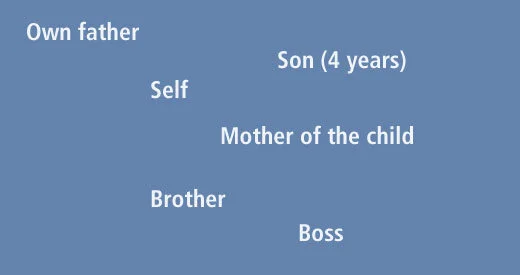2. Connection diagram and action plan
Context: This exercise is similar to the use of genograms, but is focused on visually capturing the close relationships in a person’s life.
When to use: Practitioners may use this exercise when some initial trust exists with the person. It will deepen the relevance about how you can assist the development of stronger key relationships in their life.
Conducting the exercise: Ask the person to name or write down the most important relationships in their life (these are defined as the people they influence and impact on the most or those people who influence and impact on them).
Some of these connections maybe:
children
partner/ mother of their children
extended family members
wider community members
employment context (if they identify the importance of making a difference in their job)
mates (other people they identify with in a similar situation)
other key relationships – involvement in religious groups, community services (SES, Rural Fire Service etc)
dogs/animals
On a piece of plain paper, draw a small circle to represent them in the centre. Then they draw a circle to represent each individual relationship they have named. Relationships that are closer, or that have a greater influence and impact, are placed closer to the centre of the paper. Relationships that are more distant are placed further away, near the side of the paper.
Extension questions:
Identify relationship changes by asking:
A few years ago, how would this diagram been different?
What has changed?
What has not changed?
Choosing one important relationship, what do you want to achieve?
Discuss who they have an impact on, who they influence and who they respect? Also who are the people who impact, influence and respect them...?
If you could influence one key relationship, which one would you choose?
Using Strength cards for men (free download from www.groupworksolutions.com.au), identify and name key strengths they use to create strong, safe and special relationships (as shown in the diagram). Place these cards on the outside edge of the paper. Discuss and link the strengths to important values the person uses to live life (i.e. honesty, integrity, caring). Thinking of the forthcoming week, these values need to be recorded, along with the actions they going to do to support these relationships.
The development of conscious values and a purposeful plan can help widen the range of choices they use. Encourage the person to ACT:
Accept what they are feeling and develop an idea about what is important
Connect to an important set of personal values
Take action
This identifies and builds on the primary generative motivations.

